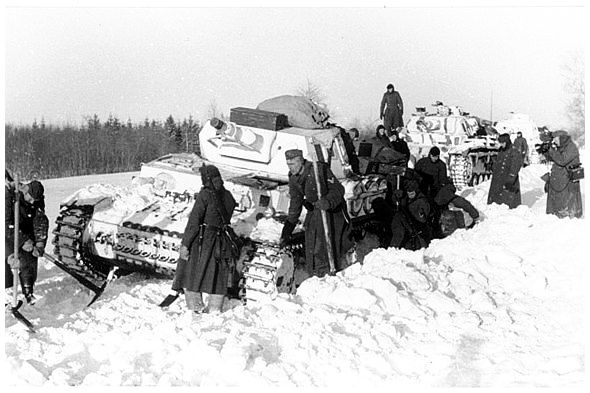
Snow!
Colonel-General Guderian was near Teploie on the night of November 3-4, 1941, where the day before, the leading infantry elements of LIII Corps had run into a large Russian force comprised of two cavalry divisions, five rifle divisions, and a tank brigade. The Russians were able to make some progress thanks to the mobility of their T-34 medium tanks in the stifling mud, whereas the Germans had had to leave behind all of their heavy equipment. In the middle of this tenuous situation, Guderian’s chief of staff handed him a detailed operations plan, prepared weeks before, for a general resumption of the offensive on 4 November, including a sharp counterattack by mobile elements of Geyr von Schweppenburg’s XXIV Panzer Corps. The plan detailed extensive German movements over ground assumed to be hardened by frost and new snowfall. The commander of 2 Panzer Army was dumbfounded. “How can you prepare an entire operational plan based on the supposition that it will snow tonight?” Guderian demanded. “Herr General,” his adjutant protested, “it’s Turn 22″. “Ah yes,” the Colonel-General replied. “You are right”.
Every eastern front gamer knows about the November snow. It’s the time after the muddy season when you get to attack for a couple more turns, until the Soviets get all their reinforcements and the counteroffensive comes. I learned about it way back when, in this game.
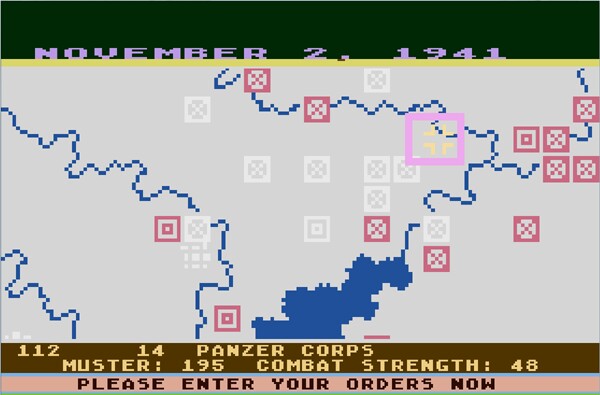
If you know exactly what that screenshot means without having to ask, then you and I have something to talk about over a beer next time we run into each other. For those reading this without the handicap of a prior history of wargaming, that’s Chris Crawford’s masterpiece, Eastern Front 1941, on the Atari 400/800 series. I was in 8th grade when my friend Barry got his copy through the Atari Program Exchange. We spent hours at his house trying to find ways through the Soviet defenses. I later got the cartridge version for my Atari 400, and eventually beat the game by eliminating all the Soviet units and lining up as many German units as possible on the eastern map edge. I got that screenshot by downloading an emulator and playing through twenty turns. And then the snow came.
By the time I first played Crawford’s gem, I had already been exposed to Avalon Hill’s Stalingrad and The Russian Campaign, as well as SPI’s Drang Nach Osten. But I had never seen a game in which, when the weather turned to mud or snow, the color of the map changed. That was a sort of epiphany for me in terms of what computer wargaming could do that board wargames couldn’t. Even then, I didn’t really wish that games could track how many individual tanks or litres of fuel an armored division had, or whether the drivers were wearing historically accurate hats. The visual weather effects seemed like a much more dramatic (and logical) improvement. It’s interesting to think back to that time, almost exactly thirty years ago, and realize that computer wargaming didn’t turn out at all the way I’d imagined.
Earl F. Ziemke’s outstanding two-volume Eastern front history describes the seeming paradoxical effect that the coming of winter had on the renewed German attack in front of Moscow.
Bock’s armor had made good progress in the first three days of the offensive. The ground was frozen hard and dusted with light, dry snow. The Germans had painted their tanks, trucks, and guns white to blend in with the landscape. Shortening days, low-hanging clouds, and snow flurries restricted air support, and temperatures ten to twenty degrees below freezing were new to troops so far accustomed to campaigning in warmer seasons. On the other hand, armor could move across country as if it were on paved roads. The fall mud and the summer’s dust and mosquitos were gone. The scenery was also improved. The Belorussian forests and swamps had given way to the Moscow upland dotted with prosperous-looking villages clean under the new-fallen snow.
This, the Germans were uneasily aware, was not the real Russian winter. Fighting then would be altogether different. Third Panzer Group had already told the OKH [German High Command] that while infantry could be made mobile in the coldest weather and the deepest snow, tanks and trucks did not respond like men and could not be ordered to master difficulties they were not built to meet. But meteorological statistics from as far back as the nineteenth century gave no reason to expect heavy snow and extreme low temperatures before mid-December.
I guess even back then no one could be bothered to read the manual, where it clearly states that blizzard conditions begin on Turn 25. But I’ve known that this was coming all along, and was ready to make one last push before the inevitable Russian counteroffensive the end of the scenario.
By the time I got to Turn 22, I realized I was probably not going to be able to take Moscow. The Russians had built up too extensive a defense to breach in just three turns. To give you an idea of what kind of hammer blows I needed to use to clear just one line of hexes, I’ve included another animated gif below. Yes, there are a lot of things going on. The red, green, and black lines are all air missions, the effect of which we examined a few diaries back. Just pay attention to the modified combat values on each side. It’s not shown here, but when I attacked Moscow, the defenders there are over three thousand. I have no idea if that is before or after a failed leader check.
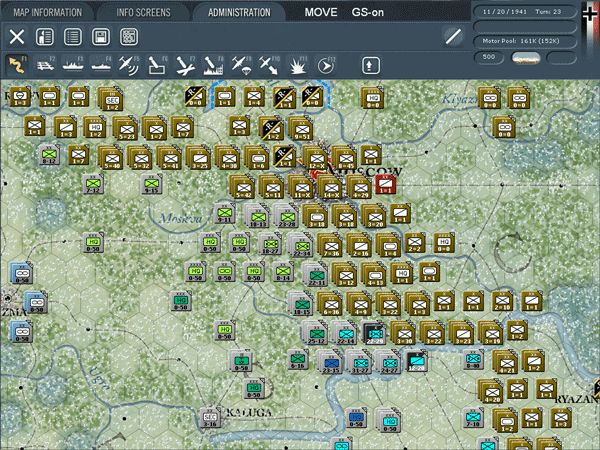
I did not capture any Moscow hexes.
Of all my decisions in the game I’ve been playing for the past six weeks, the one I’d most question is the decision to send 2 Panzer Group on a “right hook” through Tula. Historically, this is what the Germans did also, but this was in conjunction with a simultaneously northern pincer through Kalinin, which I didn’t adopt because strong Soviet defense south of Rzhev funneled my armor southward. I probably should have concentrated my forces on a narrower front. Instead, a large part of my force got stuck south of the Oka River, about 60 miles south of Moscow. Because of my supply situation, the panzers didn’t have the movement points to attack across the river, and by the time I brought up enough infantry to make a proper river assault, the mud came. That left them with three snow turns to drive six hexes and assault Moscow, and that just wasn’t going to happen. That’s good experience for next time. I’m sure that’s what Guderian said, too.
A poor supply situation is not something that affected Army Group North. Because of the ease of repairing track in the Baltic Rail Zone (because railways in the Baltic States used central European narrow-gauge rather than Soviet wide-gauge track) I was able to keep my railheads close to the front, especially since I reached Leningrad sooner than I did Moscow. As a result, my panzer corps in the north were almost at full strength when I started my final assault on the city previously known as St. Petersburg. Last time you saw the muddy assault across the Neva River. On the first snow turn, I expanded that bridgehead. On the second snow turn, the southern hex of Leningrad fell. On the last turn of the game, the northwest Leningrad hex fell. The Finns are released!
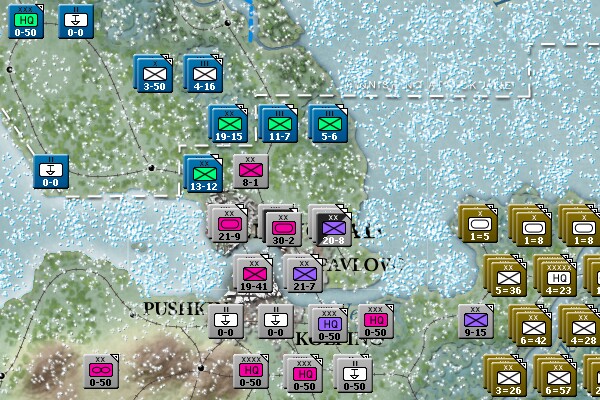
This leads us to the final part of our odyssey, a little epilogue called The Race to Voronezh. Far south of the main Moscow action sits a large industrial city in the Central Black Earth region of Russia called Voronezh. It fell to the Germans in 1942 as part of the summer offensive which ended as we all know at Stalingrad. But in this scenario, the Soviets get 30 points if they control it at the end of the game. I’ve been pushing the Russians back on a broad front between Orel and Kursk, and with 2 Panzer Group being unable to assist in the attack on Moscow, I now turn part of it south for a two-turn thrust southeast through thin opposition. The two panzer divisions of 40th Panzer Corps, my only panzer reinforcements of the whole campaign, help clear the way. On turns 23 and 24, 46th Panzer Corps drives the Soviet defenders out of the city.
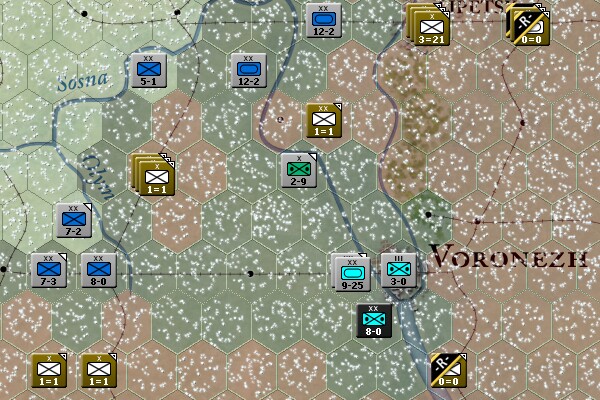
It’s an artifact of the “end of scenario syndrome” which makes you do crazy things because the world will come to a halt next turn. But it costs the AI exactly 30 victory points, so it makes perfect game sense. In a longer scenario, I could never hold that through the winter, and could possibly lose an entire panzer corps.
If this were the grand campaign game, I would now be subject to the winter counteroffensive. Instead, we just count up the victory points and declare a winner. The suspense is killing me.
Discussion
No comments yet.